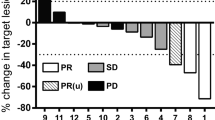Abstract
The bispecific monoclonal antibody (bsmAb) 2B1, targeting the extracellular domain of c-erbB-2, the protein product of the HER-2/neu proto-oncogene, and FcγRIII (CD16), expressed by human natural killer cells, neutrophils and differentiated monocytes, mediates the specific cytotoxic activity of these effector cells to tumor cells. A group of 24 patients with c-erbB-2-overexpressing tumors were treated with intravenously administered 2B1 in a phase I clinical trial and followed after treatment to evaluate the diversity and extent of the 2B1-induced humoral immune responses. As expected, 17 of 24 patients developed human anti-(murine Ig) antibodies (HAMA) to whole 2B1 IgG in a range from 100 ng/ml to more than 50 000 ng/ml; 10 of these patients (42%) had strong (at least 1000 ng/ml) HAMA responses, some of which were still detectable at day 191. These responses were usually associated with similar reactivity to the F(ab′)2 fragments of the parental antibodies 520C9 (anti-c-erbB-2) and 3G8 (anti-CD16). We sought evidence of an idiotypic cascade induction, indicating a prolonged specific treatment-induced effect on at least one selected target of 2B1. Using competition-based enzyme-linked immunosorbent assays, specific anti-idiotypic antibodies (Ab2) were detectable against 520C9 in 11 patients and against 3G8 in 13 patients. Peak anti-idiotypic antibodies generally occurred 3–5 weeks from treatment initiation, with a downward trend thereafter. There was a statistically significant correlation among the induction of significant HAMA responses, anti-idiotypic antibody production and the development of antibodies to c-erbB-2. The anti-c-erbB-2 responses, which were distinct from anti-anti-idiotypic (Ab3) antibodies, were detected in the post-treatment sera of 6/16 patients examined. No obvious correlation could be made between the development of humoral immune responses, the dose received, and the clinical response. Future investigations involving 2B1 therapy will concentrate on investigating an association of these humoral responses to any c-erbB-2-specific cellular responses. Manipulations of 2B1 therapy effects that augment immunity to c-erbB-2 could provide additional avenues for immunotherapy with this and other bispecific antibodies.
Similar content being viewed by others
Author information
Authors and Affiliations
Additional information
Received: 1 August 1996 / Accepted: 28 March 1997
Rights and permissions
About this article
Cite this article
Clark, J., Alpaugh, R., von Mehren, M. et al. Induction of multiple anti-c-erbB-2 specificities accompanies a classical idiotypic cascade following 2B1 bispecific monoclonal antibody treatment. Cancer Immunol Immunother 44, 265–272 (1997). https://doi.org/10.1007/s002620050382
Issue Date:
DOI: https://doi.org/10.1007/s002620050382




